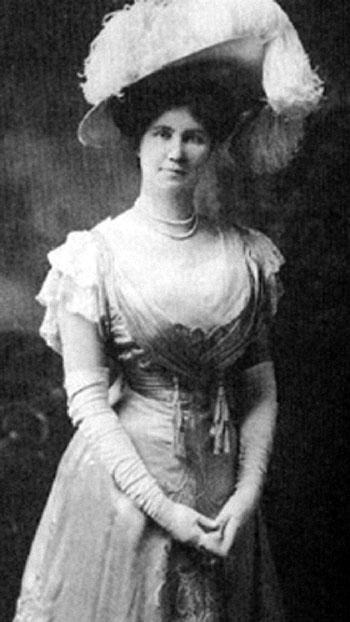 Photo: Carolyn Wells (1862-1942) wrote the first how-to book for mystery writers
Photo: Carolyn Wells (1862-1942) wrote the first how-to book for mystery writers
In 1913, the Home Correspondence School published Carolyn Wells’ The Technique of the Mystery Story, the first how-to manual for prospective writers of detective and mystery fiction. Today its value is purely historical, giving a detailed account of the kind of mystery Wells and her contemporaries were producing in the years before World War I.
In subsequent years, Wells would be joined at the lectern by such mystery practitioners as Nigel Morland, Marie F. Rodell, Patricia Highsmith, Robert Turner, Joan Lowery Nixon, H.R.F. Keating, Shannon O’Cork, Larry Beinhart, Dean R. Koontz, William G. Tapply, and Carolyn Wheat.
Approaches have been as varied as the writers doing the instructing. One who maps out every move in advance might stress the nuts and bolts of the writing process, while one who sits down at the keyboard and lets fly with no idea where the story is going might take a more inspirational or cheerleading stance. The best how-to books provide a measure of both elements. Early technical manuals concentrated strictly on literary concerns (plotting, style, characterization, research), but those written for the contemporary market are expected also to deal with the business aspects of writing (getting published, finding an agent, promoting the work).
These how-to books have a wider audience than aspiring writers. Apart from biographical and critical insights into their authors, they often can be read purely for entertainment.
Lawrence Block’s Write for Your Life, self-published to accompany seminars he conducted in the 1980s and something of a rarity because of its limited distribution, has been made available as an ebook by HarperCollins. It will undoubtedly be sought by Block collectors and fans who never intend to write a word for publication.
Certain pieces of advice recur in manuals on fiction writing—avoid substitutes for “said”; don’t worry about a bad first draft; avoid agents who charge reading fees; include plenty of conflict; don’t overdo dialect; show, don’t tell; write what you know; research what you don’t know; cultivate booksellers— but the modes of delivery vary tremendously, as the six in-print volumes considered here demonstrate.
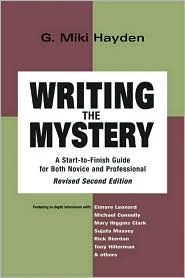 G. Miki Hayden begins Writing the Mystery provocatively, telling new writers what a good time it is to break in. Publishers are dumping established authors in their quest for the next blockbuster and looking for newcomers who will work cheap. Hayden pays more attention to e-books, independent presses, and the short-story market than most competing works. But her meandering style needs editing; her descriptions of cozy and hard-boiled fiction are exaggerated, and her carelessness with names (John D. and Ross “McDonald”; Jane “Austin”) and dubious statements do not inspire confidence. Most stories in Ellery Queen’s Mystery Magazine and Alfred Hitchcock’s Mystery Magazine do not “verge on novella length” as she believes, and both magazines are more receptive to new talent than she suggests.
G. Miki Hayden begins Writing the Mystery provocatively, telling new writers what a good time it is to break in. Publishers are dumping established authors in their quest for the next blockbuster and looking for newcomers who will work cheap. Hayden pays more attention to e-books, independent presses, and the short-story market than most competing works. But her meandering style needs editing; her descriptions of cozy and hard-boiled fiction are exaggerated, and her carelessness with names (John D. and Ross “McDonald”; Jane “Austin”) and dubious statements do not inspire confidence. Most stories in Ellery Queen’s Mystery Magazine and Alfred Hitchcock’s Mystery Magazine do not “verge on novella length” as she believes, and both magazines are more receptive to new talent than she suggests.
Hayden also gives some questionable advice. Sure, go ahead and send out simultaneous submissions without informing the recipients. Murmur, mumble, and mutter instead of say? Go for it. Tom Swifty adverbial dialogue tags? No problem. While Hayden is a skilled writer of short stories, reading her instruction manual would not be likely to attract anyone to her fiction.
Jean Hager is an expert crafter of traditional mystery puzzles, but How to Write & Market Your Mystery Novel wouldn’t necessarily make me want to read her novels. She offers good advice, but her approach is more simplistic and mechanical than most of the others. However, her brief book gathers strength as it goes along. To prove old tricks are not necessarily useless to the contemporary writer, Hager reprints Lester Dent’s 1936 Master Fiction Plot, which Dale Furutani used to develop his award-winning debut, Death in Little Tokyo.
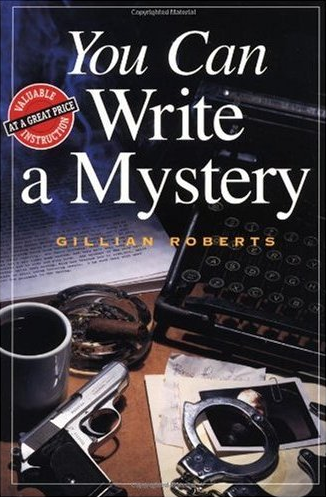 Though I haven’t read one of Gillian Roberts’ novels about schoolteacher sleuth Amanda Pepper in some years, the charm and humor of You Can Write a Mystery made me want to seek one out. Her example of awful dialogue is especially choice: “Ever since my treacherous fiancé, Humphrey, tried to force himself on you, my sister, and in a fit of anger I killed him and we buried him near the roses, I can’t sleep or eat because I’m so afraid that the gardener will dig Humphrey up and our secret will be revealed.” She is also good on style and the eternal question: “Where do you get your ideas?” Her stress on the puzzle element is heartening to those of us who believe fair-play clueing is becoming a lost art. These strengths are enough to forgive the misapprehension that Sherlock Holmes, like Nero Wolfe, is “pathologically sedentary.”
Though I haven’t read one of Gillian Roberts’ novels about schoolteacher sleuth Amanda Pepper in some years, the charm and humor of You Can Write a Mystery made me want to seek one out. Her example of awful dialogue is especially choice: “Ever since my treacherous fiancé, Humphrey, tried to force himself on you, my sister, and in a fit of anger I killed him and we buried him near the roses, I can’t sleep or eat because I’m so afraid that the gardener will dig Humphrey up and our secret will be revealed.” She is also good on style and the eternal question: “Where do you get your ideas?” Her stress on the puzzle element is heartening to those of us who believe fair-play clueing is becoming a lost art. These strengths are enough to forgive the misapprehension that Sherlock Holmes, like Nero Wolfe, is “pathologically sedentary.”
If I didn’t already know I enjoyed Roberts’ style, her how-to would attract me to her work. With Elizabeth George, the opposite is the case. Through some blind spot no doubt, I don’t care for her novels, and Write Away struck me the same way, overlong and overelaborated. Still, she is an experienced writing teacher and certainly provides helpful encouragement and sound practical advice. She stresses character to the extreme: her exhaustive system requires full character analyses before the novel is even plotted, let alone written. Her allusions are as likely to come from general literature as from mystery fiction, and her sample quotations, both from her own and the work of others, tend to substantial length. George’s admirers will appreciate the grueling and traumatic process she goes through to create her bestselling novels, reflected in the amazingly insecure and self-doubting journal excerpts used as chapter epigraphs.
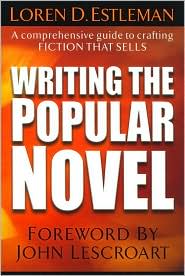 Like George, Loren D. Estleman seeks a larger audience than would-be mystery writers in Writing the Popular Novel. Estleman, who looms as large in Western as in crime fiction, is one of the finest stylists in any popular genre, and he has written the most entertaining of the six manuals under review, while also providing useful advice. He has strong views on the English language. Sample opinions: it’s okay to split infinitives, end a sentence with a preposition, and use contact as a verb (no other single word does the job); but it’s not okay to confuse imply and infer, use lay when you mean lie, or make impact into a verb (it means the same as affect). He joins Nero Wolfe in excoriating Webster’s Third. His chapter titles give an idea of the book’s pleasures: “The Rapture of Research”; “How to Ignore an Outline”; “Wyatt Earp and Me”; “Ten Things You Can Do to Avoid Success” (e.g., “End each chapter with a cliffhanger” and “Join a writer’s group”); and “Five Things Your Teacher Never Told You” (e.g., “Believe good reviews ignore bad reviews” and “If you can’t do it right, do it wrong”).
Like George, Loren D. Estleman seeks a larger audience than would-be mystery writers in Writing the Popular Novel. Estleman, who looms as large in Western as in crime fiction, is one of the finest stylists in any popular genre, and he has written the most entertaining of the six manuals under review, while also providing useful advice. He has strong views on the English language. Sample opinions: it’s okay to split infinitives, end a sentence with a preposition, and use contact as a verb (no other single word does the job); but it’s not okay to confuse imply and infer, use lay when you mean lie, or make impact into a verb (it means the same as affect). He joins Nero Wolfe in excoriating Webster’s Third. His chapter titles give an idea of the book’s pleasures: “The Rapture of Research”; “How to Ignore an Outline”; “Wyatt Earp and Me”; “Ten Things You Can Do to Avoid Success” (e.g., “End each chapter with a cliffhanger” and “Join a writer’s group”); and “Five Things Your Teacher Never Told You” (e.g., “Believe good reviews ignore bad reviews” and “If you can’t do it right, do it wrong”).
Hallie Ephron’s Writing and Selling Your Mystery Novel is the first technical manual to be nominated for the biographical-critical Edgar since that award was instituted in 1977. Purely as a textbook, it is much the best of this group. Ephron never talks around a particular writing problem but gives specific step-by-step guidance on every aspect of the process, from schedule and workspace through submitting and selling, complete with focused student exercises. Any reader who conscientiously followed her program would finish a mystery novel—not necessarily a publishable one, but the next try might be.
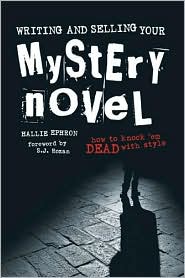 Suggestions are appropriately given with the current market in mind, but contemporary methods are not necessarily the best. Ephron gives terrible advice to Conan Doyle: “If [he] were writing the Sherlock Holmes stories today, he surely would have made Holmes the point-of-view character….Because Holmes is at the center of the action. He should be telling the story.” Sorry, Dr. Watson. Elsewhere she expresses a requirement that some (okay, I) believe reflects what is wrong with much current series mystery fiction: “You have to keep coming up with new catastrophes and life-changing crises to throw at the main character.” If the detective must be the protagonist and must go through devastating trauma, write stand-alones, not series, lest you wind up with soap opera.
Suggestions are appropriately given with the current market in mind, but contemporary methods are not necessarily the best. Ephron gives terrible advice to Conan Doyle: “If [he] were writing the Sherlock Holmes stories today, he surely would have made Holmes the point-of-view character….Because Holmes is at the center of the action. He should be telling the story.” Sorry, Dr. Watson. Elsewhere she expresses a requirement that some (okay, I) believe reflects what is wrong with much current series mystery fiction: “You have to keep coming up with new catastrophes and life-changing crises to throw at the main character.” If the detective must be the protagonist and must go through devastating trauma, write stand-alones, not series, lest you wind up with soap opera.
Under the joint pseudonym G.H. Ephron, Hallie Ephron writes novels with Donald Davidoff about forensic neuropsychologist Dr. Peter Zak. I have not read them, but her lively style, her sense of humor (wryly countering a writer cliché, she notes, “My characters never take over. How I wish they would”), her stress on the role of clues, and the professionalism she evinces in this guide make me want to try one.
Whether read for enjoyment or instruction, most how-to-write-a-mystery volumes reflect a commendable professional generosity. Any mystery writer who found producing a technical manual a more lucrative use of working hours than writing another novel probably wouldn’t be worth reading in either format.
This article first appeared in Mystery Scene Summer Issue #95.


